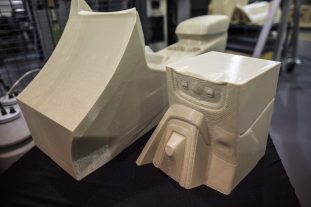
3D printing: Ford pilot project goes large
By PLANT STAFF
Industry Innovation & Technology Automotive Manufacturing 3D printing automotive Ford manufacturing StratasysStratasys’s Infinite Build 3D printer tests large-scale car part printing and lightweighting.

Stratasys Infinite Build 3D printer at work.
PHOTO: FORD
Since the Ford Motor Co. was founded June 16, 1903, it has racked up a number of firsts, among them on the manufacturing side are the moveable assembly line (1913) and automated stamping of body parts (1950). Now it can add piloting large-scale 3D printing to the list.
The automaker is running a project with Stratasys, a manufacturer of additive manufacturing systems based in Eden Prairie, Minn., that’s testing the production of big, single-piece units as prototypes, auto parts and components.
The new Stratasys Infinite Build system, housed at Ford’s Research and Innovation Center in Dearborn, Mich., grows large, lightweight thermoplastic parts with repeatable mechanical properties horizontally out of a chamber.
Ford recognizes the Stratasys system as a potentially more efficient and affordable way to create tooling, prototype parts, make components for low-volume vehicles (such as performance cars) and produce personalized car parts.
The Infinite Build works in much the same way as a conventional industrial 3D printer. It analyzes CAD specifications then prints one layer of material at a time, gradually stacking them into a finished 3D object. But when the system senses the material canister is empty, a robotic arm automatically replaces it with a full one, allowing the printer to operate unattended for hours, even days.

Prototypes of interior console components. PHOTO: FORD
This capability would make the automaker more nimble as it creates design iterations, says Ellen Lee, Ford technical leader, additive manufacturing research.
“We’re excited to have early access to Stratasys’s new technology to help steer development of large-scale printing for automotive applications and requirements.”
Automotive opportunities
The time is right to test the printer’s potential. Declining prices, new materials and expanding applications are driving the global market for 3D printers, according to Global Industry Analysts Inc., a market intelligence firm in San Jose, Calif. It’s projecting sales of $16.8 billion by 2022.
“There’s a lot of opportunity, especially looking at automotive-related materials that meet all the requirements (of automotive applications),” Lee said.
Materials that interest automotive users include aluminum and carbon, glass fibre and plastics composites.
A SmarTech study forecasts growing demand from the automotive sector with the rise of capable composites generating $530 million in sales by 2021.
There are plenty of benefits as the technology advances, especially in automotive production where the ability to produce lighter-weight parts translates into improved fuel efficiency. For example, Ford notes a 3D-printed spoiler could weigh less than half its cast metal counterpart.
On the prototyping side, developing a new intake manifold would normally involve an engineer creating a computer model of the part, then waiting months for the prototype tooling. Ford can 3D-print the manifold in a couple of days.
The technology isn’t fast enough for high-volume work, but at low volume and minus the constraints of mass-production, it creates a host of lower-cost possibilities for more timely production of specialized parts that function more efficiently.
This article appeared in the October-November 2017 print issue of AutoPLANT.
